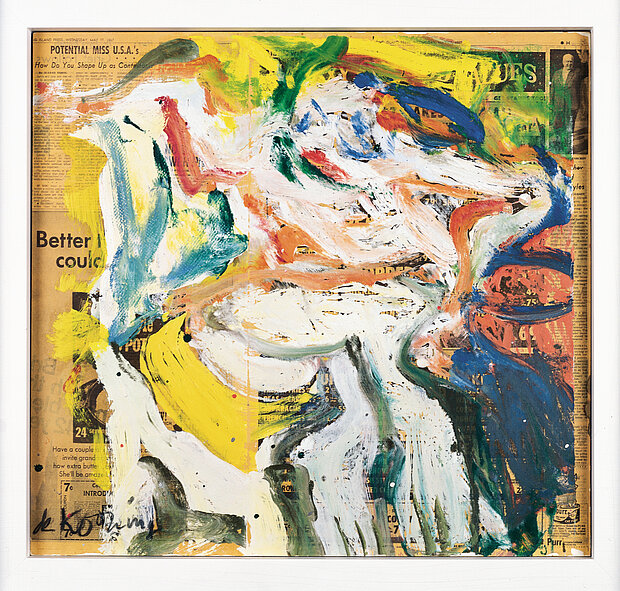
De Kooning, Willem
Untitled
1967

© mumok
| Object description | Oil on newsprint |
|---|---|
| Object category | painting |
| Material |
Painting layer:
oil paint
Newspaper:
paper
Support:
plywood
|
| Technique |
Object:
oil paintings
|
| Dimensions |
Weight:
weight: 11 kg
Object:
height: 55 cm,
width: 60 cm
Frame:
height: 70 cm,
width: 73,3 cm,
depth: 9 cm
|
| Year of acquisition | 1991 |
| Inventory number | ÖL-Stg 247/0 |
| Creditline | mumok - Museum moderner Kunst Stiftung Ludwig Wien, Leihgabe der Österreichischen Ludwig-Stiftung |
| Rights reference | Bildrecht, Wien |
| Further information about the person | De Kooning, Willem [GND] |
| Literature |
Willem de Kooning Adolf Frohner : Zeichnung : Werkverzeichnis Band 3 |
Newspaper is glued onto a small-format wooden board. We can read the date of the publication: Wednesday, May 17, 1967 and one of the headlines: Potential Miss USA. The photo shows the then Russian Prime Minister Nikita Khrushchev. The rest of the page however remains concealed behind brushstrokes in bright primary colors. By means of the newspaper format, Willem de Kooning embeds a piece of reality into the picture, which broadens its significance with regard to everyday aspects. The sketchy area of the strokes resembles the artist’s signature style and points to a concurrently created series of works dealing with the image of women conveyed in advertising. At the same time, de Kooning produces so-called newspaper transfers by pressing newspaper onto the wet surface of the pictures and carry on using them. That way the transfers become a point of reference, a trace of the genesis of his pictures including a repeated design. The artist described the coming into being of his work as follows: “I am working for weeks and weeks on a large picture and have to keep the paint wet so I can change it over and over.” Together with Jackson Pollock, Willem de Kooning is regarded as one of the main representatives of abstract expressionism. Influenced by early European Modernism he finds his own form of abstraction characterized by indicative brushwork and bright colors at the end of the 1940s although never completely forsaking figurative motifs.
© mumok – museum moderner kunst stiftung ludwig wien